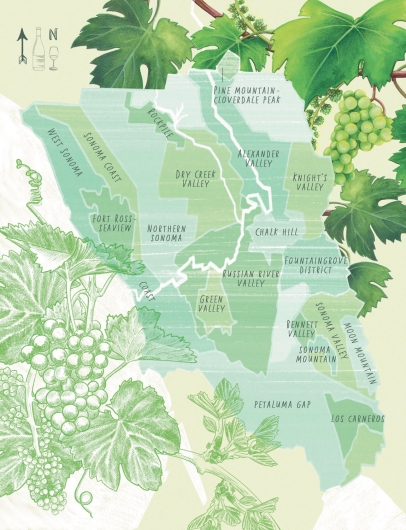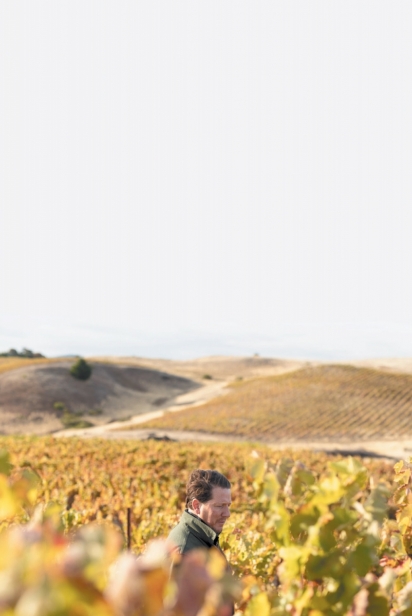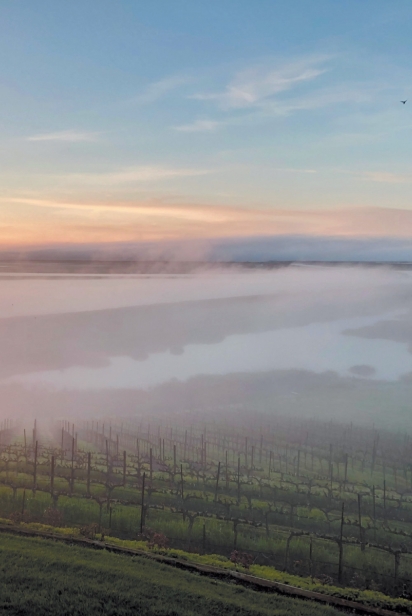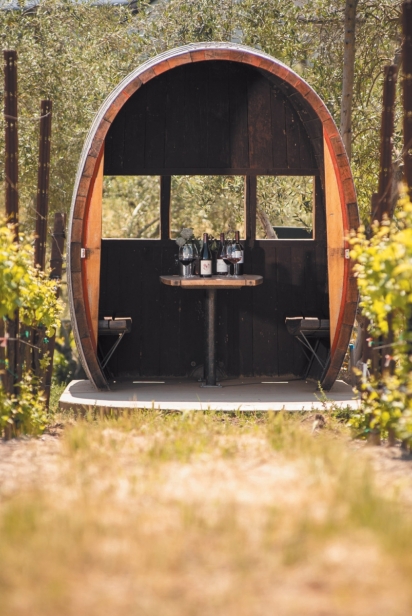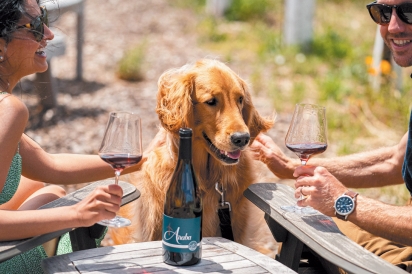Sonoma
Never has one word held so much meaning
Sonoma. The word drips like olive oil off the tongue, and for generations has embodied a meaning unto itself. It is at once rugged, rural and yet refined; simple but sophisticated; equal parts artisan and agrarian. Like words in other languages that are said to be somehow untranslatable, Sonoma has a meaning all its own and would require volumes to properly define. The moniker has been adopted by corporations ranging from Asics to General Motors, seeking to boost their own by tagging onto the reputation of this magical place.
In the language of the Indigenous Pomo people, the word translates roughly into “valley of the moon,” though like everything else that once belonged to the Native Peoples, the name itself was taken by force and today belongs to those who moved in far more recently.
Sonoma is a county, a valley, a lake, a mountain range and a township—but most of all, perhaps, it is a lifestyle. A lifestyle that, of course, includes wine. To those familiar with viticulture, it is a life that includes both hard work and gracious periods of rest. To raise grapes and turn them into wine is labor-intensive to say the least, yet when the labor is completed, the wine produced becomes a central part of the festivity, camaraderie and relaxation that, without it, could never fully take place.
For the word Sonoma to conjure any meaningful thoughts about wine, however, it must be understood not as a monolith, but as a place as diverse, complicated and beautiful as the people who live there and the wines that they make. For between the gently rolling waves of the Pacific Ocean and the jagged tree-covered outcroppings of the Mayacamas Mountains that separate Sonoma Country from Napa to the west, no fewer than 19 AVAs exist. AVAs, or American Viticultural Areas, are government-designated [specifically the Alcohol and Tobacco Tax and Trade Bureau of the U.S. Department of Treasury, known as the TTB] appellations or origins marked by geographical boundaries as delimited grape-growing regions. In order to be recognized as such, these areas must possess distinct characteristics, what the French refer to as terroir, which encompass not only weather but climate, diurnal range, continentality, terrain, soil types, the aspects of the slopes and depths of the valleys, their proximity to water, how much of it and what kind—in short, everything that affects the way grapes there are grown.
Each of the 19 AVAs currently designated in Sonoma County, and indeed there could soon be more, is worthy of a book itself, so what follows here is a primer, a listicle, an introduction that may begin to illustrate the beautiful complexities that make this place and this lifestyle so magically seductive.
ALEXANDER VALLEY AVA
Designated in 1984, the Alexander Valley AVA flanks the Russian River on both sides throughout the northern end of Sonoma County. Hot, arid summers moderated by upwards of 50 inches of annual rainfall and a Mediterranean climate make it ideal for Bordeaux varietals, and the Alexander Valley AVA is celebrated for its Cabernet Sauvignon. The historic Simi Winery, established in the late 19th century, is located here, alongside other famous producers including Jordan, Silver Oak, Seghesio, Zialena and Alexander Valley Vineyards, among others. AlexanderValley.org.
BENNETT VALLEY AVA
The Bennett Valley is a small AVA located southeast of Santa Rosa and surrounded by other AVAs. Established as an AVA in 2003, predictable morning fogs help to extend the growing season in soil that is largely volcanic. While Bennett Valley is suitable for numerous varietals, the area bases much of its reputation upon the production of Merlot, Syrah and other Rhone varietals. More recently, Burgundian varietals including Pinot Noir and Chardonnay have also emerged as popular favorites. BVGG.org.
CHALK HILL AVA
Where the Russian River ceases to trace the Alexander Valley and takes a meandering line westward toward the Pacific, you will find the Chalk Hill AVA. The suggestive name conjures images of volcanic ash, or more accurately quartzite-rich volcanic tuff, which is ideal for growing a wide variety of grapes. Chalk Hill was recognized as an AVA in October 1983. The handful of wineries that call Chalk Hill AVA their home take advantage of a general lack of regulation and grow all manner of varietals, though in white wines they tend to favor Chardonnay and Sauvignon Blanc, while the red varietals traditionally hail from Bordeaux.
DRY CREEK VALLEY AVA
The Dry Creek Valley is flanked by the Alexander Valley on the east, the Russian River Valley on the south, and is bisected by the gentle, steadily flowing creek for which it is named. If Croatia for a moment might be forgotten, then this is the home of Zinfandel. A mere 16 miles in length and two in width, Dry Creek is at best half the size of the Napa Valley, but boasts a wide variety of elevations and soil types, ranging from gravel and loam near the valley floor to dense, well-drained clay higher up in the benchlands.
Many famous Zinfandel producers have made their home upon these soils, not least Mazzocco, Pedroncelli, Seghesio and Ridge Lytton Springs. DryCreekValley.org.
FORT ROSS-SEAVIEW AVA
Fort Ross-Seaview is an AVA nested within the Sonoma Coast. In fact, it is surrounded by the Sonoma Coast AVA. Fort Ross- Seaview rises above sea level, and above the fog line, offering growers desirable altitude with meaningful proximity to the cooling presence of the Pacific. It is said that the first grapes in all of Sonoma were planted here in the early part of the 19th century, though the AVA wasn’t formally “excavated” from the Sonoma Coast AVA until 2011. Here, Burgundian varietals—namely Pinot Noir and Chardonnay—rule the roost, and Hirsch Vineyards and the iconic Red Car Wine produce consistently excellent representations of what this region can do.
FOUNTAINGROVE DISTRICT AVA
Northeast of Santa Rosa on the Napa border, this AVA was established in 2015 and is distinguished by well-drained volcanic soils and vineyards planted on the sides of mountains. The region is warm by comparison with many in the county, and grows an array of varietals, largely those from Bordeaux, and almost exclusively rooted in France.
Most growers in this region sell their fruit to others, but four wineries here have their own tasting rooms. Fisher Vineyards and Kings Hill Cellars are far enough south to have Santa Rosa addresses, while HLR Cellars and Hans Fahden Vineyards claim Napa’s Calistoga as their home. The four are close enough together that an intrepid taster could reasonably arrange to visit them all in a single day. FountaingroveAVA.com
GREEN VALLEY AVA
Green Valley touts itself as “the coolest, foggiest region of the Russian River Valley,” presumably because of the effect this climate has to offer to the Pinot Noir varietal for which the area is known. Fog and Goldridge soil—moderately well-drained soils consisting of weakly consolidated sandstone as defined by the USDA—have attracted a hundred growers to plant vineyards, and the AVA boasts some well-known producers including De- Loach Vineyards, Dutton Estate, Dutton-Goldfield and Iron Horse Vineyards. GreenValley-RussianRiver.com.
KNIGHT’S VALLEY AVA
Not long after the Judgment of Paris in 1976, Sir Peter Michael bought land in the Knight’s Valley, a stone’s throw from Chateau Montelena, and began making extraordinary wine on the site. Named for a Bear-flagger named Thomas Knight, the valley is north of Napa’s Calistoga, which is known for, among other things, intense heat. Thus, much of Knight’s Valley appears parched throughout the summer, extending the growing season and making it an ideal place to ripen fruit-forward Cabernet Sauvignon.
Referred to by one writer as “the best kept secret in Sonoma Valley,” Knight’s Valley’s fruit is highly prized and often finds its way into wines produced by high-end producers throughout Wine Country. In addition to Peter Michael Winery, a handful of others make excellent wine here, perhaps most notably Knight’s Bridge, whose state-of-the-art facility is almost entirely underground and whose spare-no-expense approach to winemaking has yielded some of the most exciting wines—in particular Sauvignon Blanc—that this writer has enjoyed recently.
LOS CARNEROS AVA
With the distinction of being the only AVA to occupy acres in both Sonoma and Napa, the Los Carneros AVA sits near the southern end of both valleys and benefits from the steady breezes that come off San Pablo Bay. Los Carneros is exceedingly cool in comparison with Knight’s Valley, Calistoga and other warmer AVAs, and as a result it is considered ideal for growing Chardonnay and Pinot Noir.
While the area is home to a number of high-end producers, it is also common to see the name of this appellation on bottles of Chardonnay and Pinot Noir produced throughout Wine Country, as it is sprawling, thoroughly planted and considered one of the premier places for growing Burgundian varietals, leading many reputable winemakers to source fruit here. In addition, Los Carneros either plays host to or supplies grapes for much of the sparkling wine production in the area. Carneros.com.
MOON MOUNTAIN AVA
East of the town of Sonoma and rising to elevations as great as 2,200 feet above the level of the nearby Pacific, Moon Mountain was established as an AVA in 2013, yet boasts some of the oldest Cabernet Sauvignon plantings in the state. From this perch in the Mayacamas Mountain Range, it’s possible to view the glint of sunlight reflecting off of the skyscrapers of San Francisco in the distance.
Moon Mountain is home to some truly iconic producers, perhaps most notably the legendary Hanzell Vineyards. Moon Mountain is also the home of a vineyard historically known as Mount Pisgah, named from the book of Deuteronomy by Jewish viticultural pioneers in the late 19th century, before it was purchased by Italian winemaker Louis Martini who renamed it the Monte Rosso Vineyard.
NORTHERN SONOMA AVA
An amalgamation of different sections of other AVAs that includes chunks of Chalk Hill, Knight’s Valley, Alexander Valley, Dry Creek Valley, Russian River Valley, Green Valley, Rockpile and Pine Mountain-Cloverdale Peak, the Northern Sonoma AVA was founded in 1985 and eludes clear definition in part because of the many more distinctive AVAs that have been carved out of it since that time. Elevation ranges wildly in this area, and partly as a result of that the varietals grown are as, if not more, diverse than any other location in the county. To understand the Northern Sonoma AVA, it is best to attempt to understand the many distinct AVAs that combine to form it—as well as those that don’t. Notable non-members of this massive tract, which takes up 329,000 acres of Wine Country, include the Los Carneros AVA and Sonoma Valley AVA, both in the far southern end of the county.
PETALUMA GAP AVA
Founded in 2017 and located near the town of Petaluma, just a short drive north of San Francisco, the Petaluma Gap AVA overlaps portions of Marin County and is laser-focused on Pinot Noir. The varietal benefits greatly from the microclimate of the area, which offers dense, reliable morning fog, and steady breezes that funnel off the Pacific through the Coastal Range and south toward San Pablo Bay, decreasing yield, increasing flavor intensity and inspiring the AVA’s tagline “wind to wine.”
Many tasting rooms are located within the AVA, including such notable producers as Adobe Road, Keller Estate and Macrostie. Seemingly countless other devotees of Pinot Noir source fruit from the area. Some of the better Pinots this writer has had from the Petaluma Gap include the wines of Bryter Estate, Pellet Estate, Pax Mahl [Pax Wines] and Schug. PetalumaGap.com.
PINE MOUNTAIN-CLOVERDALE PEAK AVA
A small appellation in the Mayacamas, above the town of Cloverdale and near the border of Mendocino County, Pine Mountain- Cloverdale Peak’s elevation rises from a low of 1,600 feet to a high of 2,600—one of the highest-altitude AVAs in California.
The general topography is steep and rocky, with a heavily volcanic soil composition. The cool temperatures and prolonged exposure to sunlight that come with this high-altitude territory have endeared the region to lovers of Cabernet Sauvignon, which ripens late as a result of these climes and can linger on the vines late into the harvest, concentrating intense flavors into small fruit with low yield. Massive producers such as Francis Ford Coppola Winery, Jackson Family and Imagery Estate have all been attracted to the area, establishing vineyards there which are juxtaposed alongside boutique producers such as Pine Mountain Vineyards. PMCPAVA.org
ROCKPILE AVA
Aptly named, it is in part the rocky terrain and accompanying high elevation, and in part the nearly consistent sun-facing aspect of the vineyards, which benefit from the proximity to Lake Sonoma in their quest to produce primarily red varietals. Perhaps best known for Zinfandel, northern Sonoma’s Rockpile also produces some amount of Cabernet Sauvignon and other varietals. Dramatic vistas and concentrated fruit are the calling cards of this AVA.
RUSSIAN RIVER VALLEY AVA
Part appellation, part force of nature, part legend, the Russian River Valley may be the most famous AVA in Sonoma County— and for good reason. This is the home of J. Rochioli Vineyards, Three Sticks, Williams Selyem, and many, many other legendary wineries. Benefiting tremendously from its proximity to the Sonoma Coast, reliable fog cover and sandstone and sandy loam soil types, the Russian River Valley has long been heralded as an American Bourgogne for its Pinot Noir and Chardonnay.
Added benefits of a visit to the Russian River Valley include easy access to numerous high-end luxury hotels and quaint B&Bs, and a wide array of excellent restaurants. The broad, gentle folds of the Russian River are also teeming with smallmouth and steel-heads for wine-loving fisherfolk, and a great place to drop in with a kayak or canoe. RussianRiverValley.org
SONOMA COAST AVA
There is a place where the fiery star that heats our world and sustains life for grapes and grape growers alike descends dramatically into the Pacific every night. Home to some of the most inspiring sunsets to be found anywhere in the continental United States, the Sonoma Coast AVA runs the length of the county from the Mendocino border in the north down to San Pablo Bay in the south, tracing the Pacific coastline and engulfing in whole or in part numerous smaller AVAs as it does so. Boasting the coolest climates and some of the highest levels of annual precipitation to be found in the entire county, this elongated expanse of grape-growing land is best understood as the miracle of turning water into wine. Pinot Noir and Chardonnay are the logical loves of grape growers in this region, though tightly wound cool-climate Syrah has made a name for itself here as well. VisitSonomaCoast.com/sonoma-coast-ava
SONOMA MOUNTAIN AVA
West of Moon Mountain, between Bennett Valley and Los Carneros, the Sonoma Mountain AVA is both diminutive and dramatic. Nested within the Sonoma Valley AVA near the quaint town of Glen Ellen, the soils here are mountainous and rocky. Located above the fog line, the area gets direct sunlight all day long, yet remains cool due to altitude and lake effect. The diversity of this microclimate had led growers to conclude that there’s little that can’t be grown in this small space, and they’re probably correct. Widely heralded wines from the region include elegant Cabernet Sauvignons, delicate Pinot Noirs, spicy Zinfandels and hefty Chardonnays.
SONOMA VALLEY AVA
Established in December 1981, Sonoma Valley became California’s seventh and the nation’s ninth American Viticultural Area. The narrow floor of the valley rests between the Mayacamas Mountains on the east and the Sonoma Mountains on the west, and is the prominent home of Sonoma wine for most intents and purposes. Here, one can visit historic wineries such as Gundlach- Bundschu and Kunde, newly beloved producers such as Ledson and Mayo Family, cutting-edge winemaking operations such as En Garde and Hawkes, and classically driven Italian-in- fluenced wineries such as Muscardini and VJB Cellars. Here, just west of the town of Sonoma, members of the Robledo Family who came to Wine Country as migrant workers to tend to the vines in the 1940s became the first Mexican vineyard workers to establish a winery on their own land. Few places are richer with history, or more saturated with extraordinary wineries, than this, the OG of Sonoma AVAs.
WEST SONOMA COAST AVA
The new kid on the block as far as the TTB is concerned, the West Sonoma Coast AVA was one of seven American Viticultural Area’s established in 2022. Tracing the coastline and wholly devoted to Pinot Noir and Chardonnay, the region is partly the recognition of the mountainous coastline and powerful impact of the Pacific, and partly the result of a struggle to distinguish the elite wines of this region from competitors. Narrow and bisected by the San Andreas Faultline, the newly established AVA runs from Bodega Bay in the south to Gualala in the north. West- SonomaCoast.com
Sonoma. A place, indeed, and a geographically complex one at that—yet it is so much more. It is the land and the people who work it. It is viticulture and the terroir that encourages it. It is fine dining, fine wine and a fine way to spend a week—or a lifetime, if one is so inclined. Delineated into 19 distinct AVAs, each with its own vibe, reputation, strengths and personality, Sonoma is a six-letter word packed with so much meaning that one can only hope, through time well spent therein, to fully understand.


